To give you a better understanding of the gig economy, we’ve compiled all the essential gig economy statistics on the industry, the people who make it up, and how they earn.
Whether they’re trying to earn extra money on the weekends or become full-time independent workers, droves of people are looking beyond their 9 to 5 jobs to the gig economy.
Gig work provides short-term flexible jobs across dozens of industries. And thanks to technology, gig job opportunities are endless and easy to find.
Key Gig Economy Statistics
Before we get too deep into the data, it’s important to define what the gig economy is. The gig economy is a market built on short-term contracts or freelance work rather than permanent jobs.
Today, the gig economy is fueled by apps and online gig platforms that connect freelancers with work opportunities. Anything from driving for Uber to being an English tutor can be defined as a gig job.
Now, let’s look at the numbers.
There are an estimated 58 million independent workers in the United States.
By all accounts, gig work is on the rise. The number of gig workers in the US was estimated to be 58 million in the most recent American Opportunity Survey from McKinsey.
Freelancers make up 36% of the workforce in the United States.
According to Upwork’s 2021 Freelance Forward Economist Report, freelancers comprise more than one-third of the US labor market, with 59 million freelancers nationwide.
At least 90% of the US workforce is expected to freelance by 2028.
A recent study from Statista estimates that 90.1% of the workforce will be taking on freelancing work by 2028, based on the rise in freelancers over the last several years. Here’s an overview of the data:
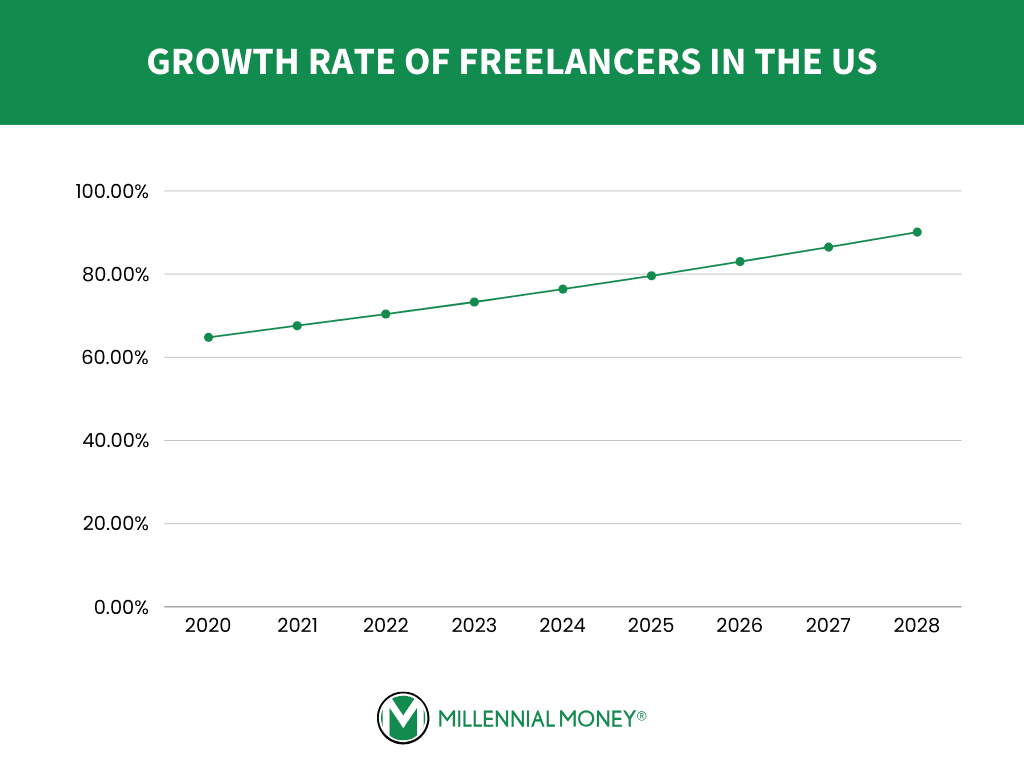
One-fifth of independent workers in the US have international customers.
The gig economy has made it easy to take your business overseas. According to data from MBO Partners, around 19% of full-time independent workers in the US have clients in other countries.
16% of Americans say they’ve used a gig website or app to make money.
In a 2021 Pew Research Center Survey, 16% of US adults claimed to have made money with an online gig platform.
We’ll take a closer look at how that breaks down by age, race, income level, and sex later.
88% of gig economy revenue comes from transportation services and asset-sharing platforms.
Research from Mastercard shows that ridesharing services like Uber and Lyft and asset-sharing platforms like Airbnb and Tripadvisor account for 88% of gig economy revenue.
Florida has the highest proportion of gig workers in the United States.
A study from ADP Research looked at the states with the highest number of employed people to see what percentage of their workforce does gig work.
Here are the 9 states with the most gig workers:
- Florida: 22%
- California: 20%
- Illinois: 18%
- Texas: 18%
- Massachusetts: 16%
- New Jersey: 16%
- New York: 16%
- Ohio: 16%
- Pennsylvania: 16%
People
Here are some essential stats on the people who make up the gig economy, including their demographics, motivations, and habits.
30% of 18-29-year-olds have used a gig platform to make money, more than any other age group.
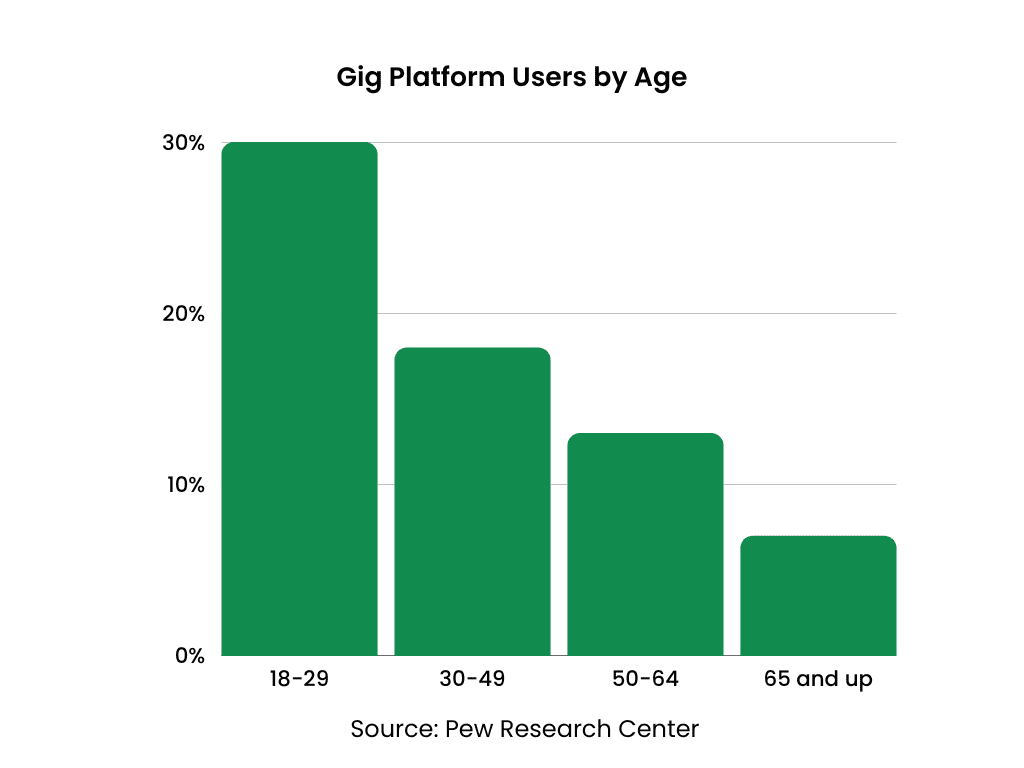
And according to Upwork, half of Gen Zers had done some type of gig work in the last year. Combined, Millennials and Gen Z make up the bulk of the gig economy.
Hispanic Americans were most likely to make money on a gig platform in the study.
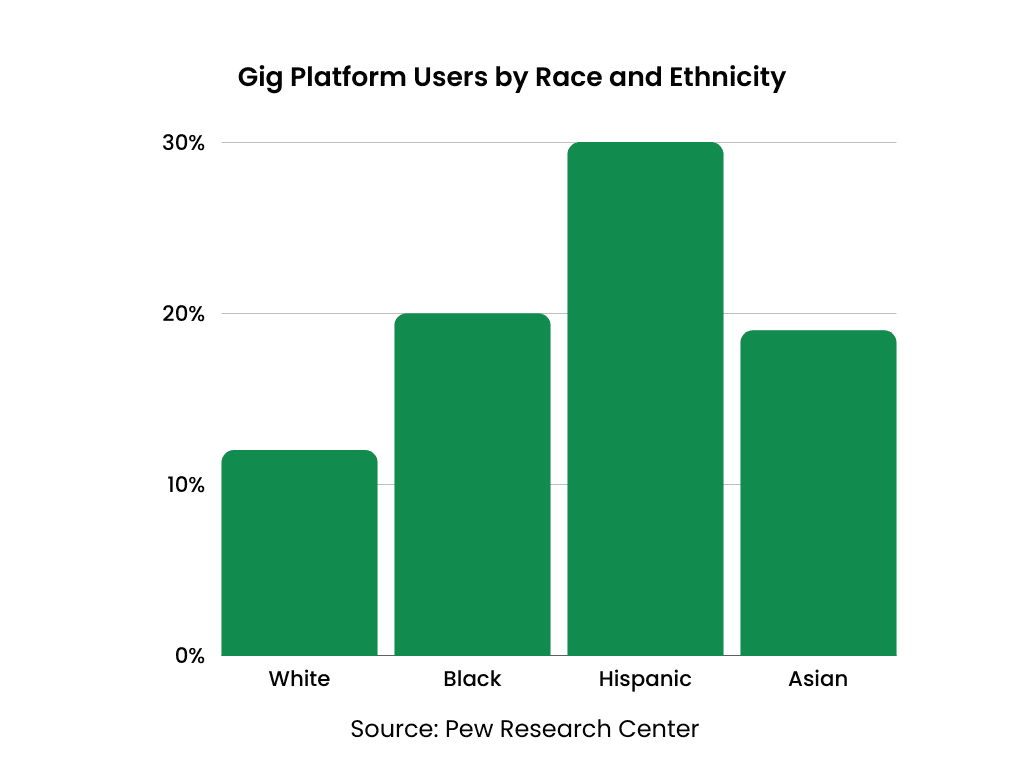
1 in 4 lower-income Americans has made money with a gig app or website.
Income has a pretty significant impact on gig work. According to Pew Research Center, 25% of lower-income Americans have turned to gig work, compared to 13% of middle-income and 9% of upper-income individuals.
Men and women participate in the gig economy at around the same level.
The survey also found that 15% of men and 17% of women are a part of the gig economy.
The biggest reason people take on gig jobs is to boost their savings.
Pew Research Center also surveyed gig workers to identify the biggest reasons they took on gig work in the last year.
At least half of the respondents said they did it to save more money, cover income gaps, or create their own schedules.
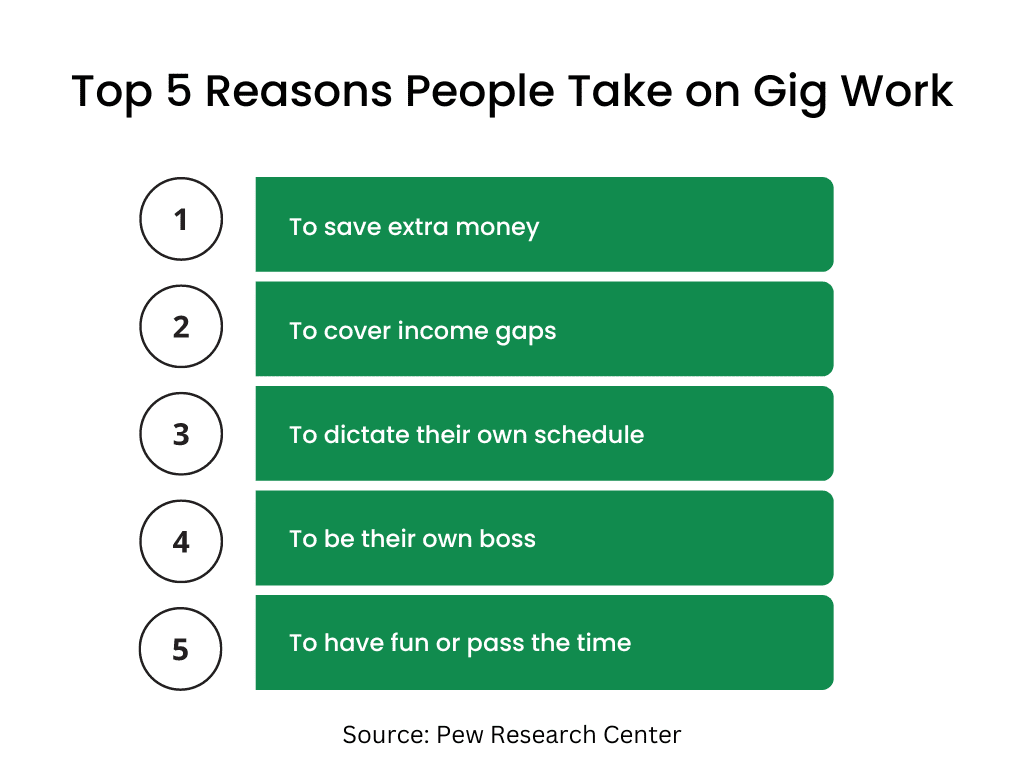
12% of US workers started freelancing during the COVID-19 pandemic.
The pandemic fundamentally changed the landscape of the workplace and popularized remote work. According to Upwork, it prompted more than 1/10th of American workers to join the gig economy.
And 67% of full-time gig workers said that freelancing prepared them better than a traditional job would have for the uncertainty that COVID brought.
65% of freelancers with a 4-year degree wish they had opted for a 2-year degree instead.
8 in 10 freelancers in Upwork’s survey said their college degrees helped them with their gig work; however, more than half of respondents with a 4-year degree wish they had supplemented a 2-year degree with online training in their field instead.
3 in 4 independent workers said they were very satisfied with their work situation in 2023.
77% of independent contractors consider themselves to be very satisfied with their jobs, and 63% say the decision to freelance was completely their choice, according to MBO Partners’s 2023 State of Independence Study.
Most gig workers spend an average of 10-20 hours on their gigs.
A survey from Zety found that most gig workers spend 10-20 hours per week on their gigs. Here’s a breakdown of how much time people put into their ventures.

Most gig workers prioritize flexibility over higher pay.
70% of self-employed workers say they’d rather have the flexibility of a gig job than a different job with a higher salary. 80% say they want to be their own boss, and 71% say they don’t like answering to a boss (MBO Partners).
54% of gig workers say they’d like to find a full-time job and keep up their gig as a side hustle.
More than half of Zety’s survey respondents said they plan to find a full-time job in the next year but still carry on with their gigs on the side.
24% said they planned to find full-time jobs and quit their gigs altogether, while another 16% said they planned to keep gigging full-time.
58% of gig workers say independence is the biggest perk of the gig economy.
In Zety’s survey of independent workers, most gig workers said independence was the biggest advantage of their career and cited the lack of employee benefits as the biggest disadvantage.
Here were the biggest drawbacks and advantages independent workers cited in the survey.
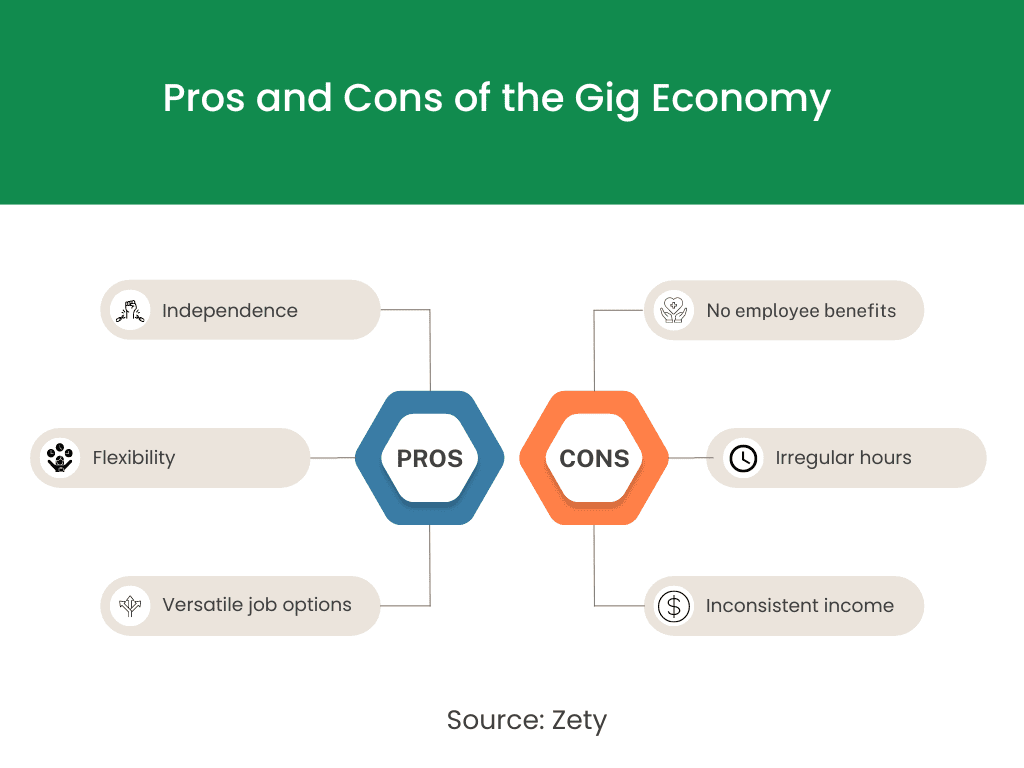
Industries
Wondering what jobs gig workers do?
The construction, recreation, and business services industries have the most gig workers.
According to ADP, these are the top 10 industries based on their share of gig workers.
| Industry | Share of Gig Workers |
| Recreation | 38% |
| Construction | 33% |
| Business services | 30% |
| Finance | 25% |
| Transportation and warehousing | 24% |
| Information services | 22% |
| Education | 20% |
| Professional or technical services | 19% |
| Hospitality and food services | 19% |
| Retail | 16% |
Half of US gig economy workers provide skilled work services.
Based on Upwork’s gig workforce survey, 1 in 2 gig workers does skilled work. This includes services like editing, virtual assisting, consulting, and computer programming.
Airbnb is the number one gig app based on monthly income.
According to a survey from Earnest Loans, Airbnb users make the most money of all sharing economy workers, earning an average of $924 per month.
Here were the top nine platforms for gig economy workers based on average monthly income:
- Airbnb: $924/month
- TaskRabbit: $380/month
- Lyft: $377/month
- Uber: $364/month
- Doordash: $229/month
- Etsy: $151/month
- Fiverr: $103/month
- Getaround: $98/month
Earnings
Here’s a closer look at how much people earn performing gig work.
On average, gig workers make an average of $5,120 per month.
According to ADP Research, full-time gig workers who consider their gigs to be their primary source of income bring home around $5,120 per month.
Gig workers outearn traditional employees in some industries, including transportation and warehousing, recreation, and professional services.
44% of freelancers say they make more money with gigs than they would with traditional employment.
Upwork’s survey found that nearly half of freelancers are earning more with their independent gigs than they could in a conventional long-term job.
1 in 5 full-time independent workers earns six figures.
Almost 20% of independents are considered high-income earners, bringing in $100,000 or more per year, according to MBO Partners’ survey data.
On average, full-time independent workers earn $69,000 per year.
According to MBO, independent professionals make $69,000 per year on average, which is higher than the median income for US households.
Women earn around 82 cents for every dollar men earn in the gig economy.
According to Zippia’s gig survey data, there’s a gender pay gap in the gig economy. Men outearn women by 10.5%, on average.
Gig Economy Outlook
So what’s the outlook for the gig economy?
Nearly half of freelancers consider their gigs to be a long-term career move rather than a short-term opportunity.
48% of freelancers think of their independent jobs as a lasting source of income and a meaningful career move (Upwork).
42% of independent workers think automation will enhance their jobs by contributing to better work/life balance.
When MBO Partners asked how automation might change people’s jobs in the future, 42% of independent workers said it would lead to better work/life balance, compared to 36% of traditional workers.
And 55% of independent workers said automation won’t have any effect on the work they do.
80% of big corporations plan to utilize more free agents in the future.
A 2020 Intuit report found that most major corporations plan to shift to using more freelancers and contractors and fewer traditional employees in the future.
Frequently Asked Questions
Who benefits from a gig economy?
The gig economy benefits employers and workers. It saves businesses money and provides them with skilled workers, who enjoy flexibility, freedom, and the ability to choose the jobs that appeal to them and work on their own terms.
Is the gig economy the future?
Based on statistics, the gig economy is here to stay. This segment of the workforce is growing rapidly each year as more people join the independent workforce on a part-time basis and others become full-time gig workers.
How do you succeed in the gig economy?
You can follow these steps to be more successful in the gig economy:
- Create productive habits and routines
- Connect with other gig workers
- Research and take courses to advance in your field
- Use the right platforms to find work
- Focus on maintaining a healthy work-life balance
What skills are needed for the gig economy?
To succeed in the gig economy, it’s important to have these skills:
- Adaptability
- Interpersonal skills
- Willingness to learn
- Self-promotion
- Time management
- Focus
- Critical thinking
The Bottom Line
The gig economy is an exciting topic to explore, and it’s becoming even more prevalent as people are reassessing their priorities and seeking out flexibility and autonomy in their careers.
While it definitely has its drawbacks, the gig economy provides tons of unique job opportunities, and it fits millions of workers’ needs.
As technology advances and the workplace evolves, it will be interesting to see how gig economy trends and perspectives change.
Sources:
- The State of Gig Work in 2021, Pew Research Center
- American Opportunity Survey, McKinsey
- The Global Gig Economy, Mastercard
- Freelance Forward Economist Report, Upwork
- The State of Independence in America, 2023, MBO Partners
- Illuminating the Shadow Workforce, ADP Research
- Gig Economy Stats, Zippia
- Workers on the Gig Economy, Zety
- Number of Gig Economy Workers, Statista
- Sharing Economy Data, Earnest
- Intuit 2020 Report, Intuit

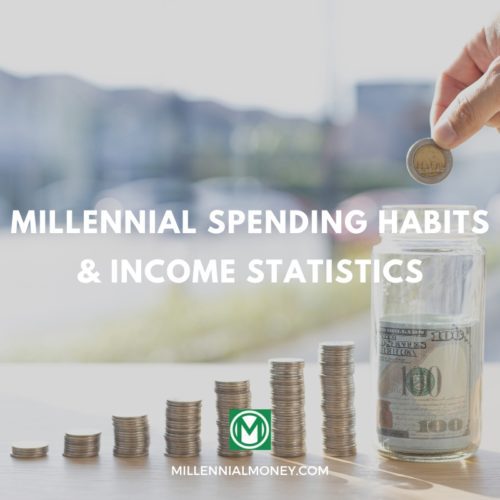



No comments yet. Add your own